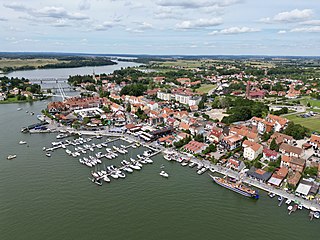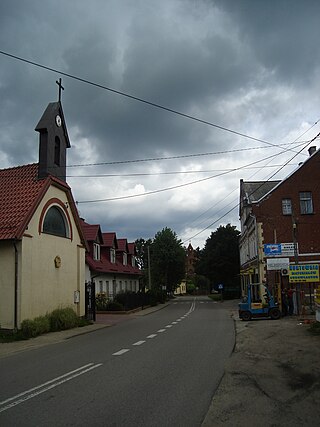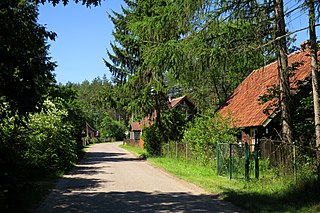
Masuria is an ethnographic and geographic region in northern and northeastern Poland, known for its 2,000 lakes. Masuria occupies much of the Masurian Lake District. Administratively, it is part of the Warmian-Masurian Voivodeship. Its biggest city, often regarded as its capital, is Ełk. The region covers a territory of some 10,000 km2 which is inhabited by approximately 500,000 people.

Warmian–Masurian Voivodeship, also known as Warmia–Masuria Province and Warmia–Mazury Province, is a voivodeship (province) in northeastern Poland. Its capital and largest city is Olsztyn. The voivodeship has an area of 24,192 km2 (9,341 sq mi) and in 2019 had a population of 1,425,967.

Mrągowo is a resort town in the Warmian-Masurian Voivodeship of northeastern Poland, with 21,889 inhabitants (2019). It is the capital of Mrągowo County and the seat the Gmina Mrągowo. The town is located in the historical region of Masuria, within the Masurian Lake District, about 60 km (37 mi) east of Olsztyn.

Giżycko is a town in northeastern Poland with 28,597 inhabitants as of December 2021. It is situated between Lake Kisajno and Lake Niegocin in the region of Masuria, and has been within the Warmian-Masurian Voivodeship since 1999, having previously been in the Suwałki Voivodeship (1975–1998). It is the seat of Giżycko County.

Olecko is a town in northeastern Poland. It is in Masuria, near Ełk and Suwałki, in the Warmian-Masurian Voivodeship. It is at the mouth of the Lega river which flows into the Great Olecko Lake on its southwestern shore. Olecko is the seat of Olecko County.

Pisz is a historic town in the Warmian-Masurian Voivodeship in northern Poland, with a population of 19,466 (2016). It is the seat of Pisz County. Pisz is situated at the junction of Lake Roś and the Pisa River, in the region of Masuria.

Mikołajki is a resort town in Mrągowo County, Warmian-Masurian Voivodeship in north-eastern Poland, with 3,852 inhabitants as of 2017. The town is located near the Śniardwy, the largest lake of both the Masurian Lake District and Poland. It is located in the center of the ethnocultural region of Masuria.

Węgorzewo is a tourist town on the Angrapa River in northeastern Poland, within the historical region of Masuria. It is the seat of Węgorzewo County in the Warmian-Masurian Voivodeship and is located not far from the border with Russia's Kaliningrad Oblast. Lake Mamry is close to the town.

Giżycko County is a unit of territorial administration and local government (powiat) in Warmian-Masurian Voivodeship, northern Poland. It came into being on 1 January 1999, as a result of the Polish local government reforms of 1998. Its administrative seat and largest town is Giżycko, which lies 88 kilometres (55 mi) east of the regional capital Olsztyn. The only other town in the county is Ryn, lying 18 km (11 mi) south-west of Giżycko.

Pisz County is a unit of territorial administration and local government (powiat) in Warmian-Masurian Voivodeship, northern Poland. It came into being on 1 January 1999 as a result of the Polish local government reforms passed in 1998. Its administrative seat and largest town is Pisz, which lies 88 kilometres (55 mi) east of the regional capital Olsztyn. The county contains three other towns: Orzysz, 24 km (15 mi) north-east of Pisz, Ruciane-Nida, 17 km (11 mi) west of Pisz, and Biała Piska, 18 km (11 mi) east of Pisz.

Ruciane-Nida is a town in Pisz County, Warmian-Masurian Voivodeship, Poland. The town was formed in 1966 by the merger of three smaller settlements: Ruciane, Nida and Wola Ratajowa. It is located within the historic region of Masuria.
This is a list of German language place names in Poland, now exonyms for towns and villages in the Masuria Region of the Warmian-Masurian Voivodeship.

Ukta is a village in the administrative district of Gmina Ruciane-Nida, within Pisz County, Warmian-Masurian Voivodeship, in northern Poland. It lies approximately 7 kilometres (4 mi) north-west of Ruciane-Nida, 22 km (14 mi) west of Pisz, and 67 km (42 mi) east of the regional capital Olsztyn.
Gmina Ryn is an urban-rural gmina in Giżycko County, Warmian-Masurian Voivodeship, in northern Poland. Its seat is the town of Ryn, which lies approximately 18 kilometres (11 mi) south-west of Giżycko and 71 km (44 mi) east of the regional capital Olsztyn.
Gmina Mikołajki is an urban-rural gmina in Mrągowo County, Warmian-Masurian Voivodeship, in northern Poland. Its seat is the town of Mikołajki, which lies approximately 21 kilometres (13 mi) east of Mrągowo and 72 km (45 mi) east of the regional capital Olsztyn.
Gmina Ruciane-Nida is an urban-rural gmina in Pisz County, Warmian-Masurian Voivodeship, in northern Poland. Its seat is the town of Ruciane-Nida, which lies approximately 17 kilometres (11 mi) west of Pisz and 71 km (44 mi) east of the regional capital Olsztyn.

Masurian Landscape Park is a designated Polish Landscape Park protected area within Warmian-Masurian Voivodeship, in northern Poland. It is one of the largest landscape parks in Poland.

Końcewo is a village in the administrative district of Gmina Ruciane-Nida, within Pisz County, Warmian-Masurian Voivodeship, in northern Poland. It is a sołectwo of Ruciane-Nida.

Puszcza Piska Forest or the Pisz Forest is the largest forest complex of the Masuria region in northern Poland, adjacent to the Masurian Landscape Park, and the Masurian Lowlands. Formerly known as the Jańsborska wilderness, Puszcza Piska bears the name of the Pisa river bordering the Forest along its west bank.

Olsztyn is a Polish parliamentary constituency in the Warmian-Masurian Voivodeship. It elects ten members of the Sejm.



















